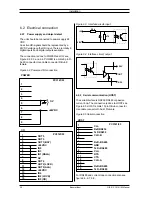
18
Baumer Ident
OIS-P, PC3141/03 Manual
The recommendations for how close Data Tags
may be to each other at a communication point are:
1. Ensure at least
a 3 dB difference in signal
strength
between the intended Data Tag and all
other Data Tags, when communication starts. If
a major difference in Data Tag exposure to
foreign substances like paint etc can be
expected, this difference should be added to the
3 dB mentioned above. Please refer to
section
3.3
.
2. The closer to each other the Data Tags must
come, the shorter the communication distance
should be. By reducing the communication
distance, it is easier to maintain a significant
difference in signal strength between the
intended Data Tag straight in front of the
antenna and not intended Data Tags.
The closer Data Tags come to each other, the
more important also the timing of object detect
activation becomes. If objects come very close
to each other, OD should be activated as the
correct Data Tag is located straight in front of the
antenna. This however means that part of the
theoretical access range is lost. For
communication with objects at standstill this
means that the object stop position is more
critical. For communica-tion with objects in
motion, it means that the available
communication time is reduced.
3. Recommendation 1 and 2 above prevents that
no communication with other Data Tags will
occur, provided that the intended Data Tag is
present and in operating order. For a better
protection against communication with nearby
Data Tags, these cannot be allowed within an
area, corresponding to 2–5 times the size of the
0 dB graph line in
figure 2.1 and 2.2.
Microwaves can, however, be influenced and
reflected by metal and directed into unwanted
areas, which has to be considered in the
installation layout.
Should this description not cover your installation
requirements or should you have any questions,
please consult your OIS-P system specialist for
advice.
2.4 Distance between antennas
To ensure that the antenna only communicates
with the proper Data Tag the recommendations
under section 2.3 must be followed.
To avoid interference between adjacent antennas,
the Interlock function should be used. This means
that two or more antennas avoid to communicate
simultaneously. Since the microwave
communication time is short, this Interlock will
normally not influence the total communication time
notably.
An Interlock function can also be realised by
sequencing the commands in the host (PLC) to the
different control units. Without Interlock the
antennas should be separated 4–10 times the size
of the 0 dB graph line in figure 2.1 and 2.2.
If for some reason the Interlock function can't be
used there is a possibility to use frequency
separated antennas. Please contact your OIS-P
system specialist for advice.
System performance
Содержание OIS-P PC 3100 series
Страница 2: ...Page intentionally blank ...
Страница 4: ...4 Baumer Ident OIS P PC3141 03 Manual Page intentionally blank ...
Страница 6: ...6 Baumer Ident OIS P PC3141 03 Manual Page intentionally blank ...
Страница 12: ...12 Baumer Ident OIS P PC3141 03 Manual System description Page intentionally blank ...
Страница 24: ...24 Baumer Ident OIS P PC3141 03 Manual Health aspects Page intentionally blank ...
Страница 26: ...26 Baumer Ident OIS P PC3141 03 Manual Page intentionally blank Maintenance aspects ...
Страница 38: ...38 Baumer Ident OIS P PC3141 03 Manual Installation and trouble shooting tools Page intentionally blank ...
Страница 42: ...42 Baumer Ident OIS P PC3141 03 Manual Page intentionally blank ...






























